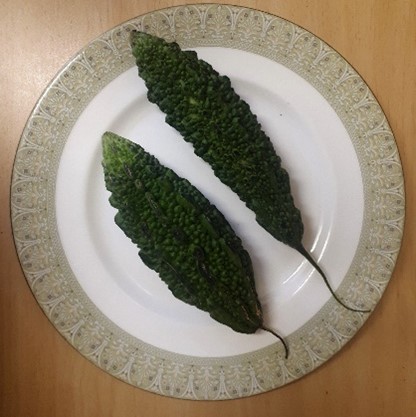

Provided here are a selection of particularly important and popular vegetables, such as Saag (Spinach) and Kerela (Bitter Gourd) – above — that feature in Nepali home cooked cuisine.
Beans — Simee
Nutrients and particularities:

Beans are cholesterol-free, fat-free, and sodium free, and are major sources of manganese, copper, magnesium, phosphorus, and especially potassium (which promotes good blood pressure). There are a number of beans or ‘pulses’ as they are also known, in Nepali and broader South Asian cuisine. One of the favourite bean dishes in Nepali home cookery is Red Kidney Bean (Ramja) – an image of Ramja Dal with boiled rice (Bhat) is provided (above). The most famous Nepali bean dish is Kwati ‘Nine Beans Soup’: (https://en.wikipedia.org/wiki/Kwati_(soup) .
Broccoli — Brokaulee
Nutrients and particularities:
Broccoli, related to Brussels sprouts, cabbage, kale, and cauliflower, is high in fibre, vitamin C, vitamin K, iron, and potassium. It has substantial protein content too.
Cabbage — Bandakobi
Nutrients and particularities:
Cabbage contains anthocyanins, known to reduce the risk of heart disease, and contains minerals, especially potassium: it is very high Vitamin C and Vitamin K.
Carrots — Gajur
Nutrients and particularities:
Carrots are a renowned health preserving root vegetable, with eye health enhancing and cholesterol lowering properties. They are a good source of potassium, fibre, beta carotene, antioxidants, and vitamin K1.
Carrots are often served in their raw (uncooked) form as a side dish in some Nepali platters, and are utilised as a material from which sculpted, decorative designs are made (flower shapes, etc.).
Cauliflower — Kaulee
Nutrients and particularities:
Cauliflower contains almost all the essential vitamin and minerals the body needs. It is weight loss friendly and contains plant compounds that may reduce heart disease and cancer.
Chickpeas – Chanaa
Nutrients and particularities:
Chickpeas (yellow and also Black [Kala/Urad chanaa]: the latter particularly used in Nepali dishes) contain calcium, iron, phosphate, manganese, zinc, and vitamin K. They are a good source of carbohydrates, fibre and are known to contribute maintaining strength and bone structure.
Chinese Cabbage — Pak Choi
Nutrients and particularities:
It is low in calories (this changes if too much cooking oil is not removed from the final stage dish), and contains a good supply of nutrients, and is said to be a vegetable which if consumed regularly, can help protect against cancer, ca assist on metabolism and digestion. Pak Choi contains folate, which plays a major part in DNA repair and generation. It also contains vitamins C and E, beta-carotene, as well as selenium.
Fermented vegetables – Gundruk and Sinki
Nutrients and particularities
Gundruk is a fermented leafy vegetable product and Sinki is a fermented radish tap-root; these are both good sources of fibre, have anti-carcinogenic effects, and contain substantial amounts of carotene, and ascorbic and lactic acids.
Gundruk and Sinki fermentation methods involve sinking vegetable leaves and radish tap-root in the ground in containers with in the case of Gundruk in particular, some water added to enable fermentation by rotting (the process takes from one to several weeks). Both are delicious as a tasty accompaniment to most Nepali dishes, vying with spiced pickled vegetables (Achar).
Mainly produced in the Himalayan regions of Nepal, Gundruk and Sinki are sought after by overseas Nepali diaspora members, conveyed in jars as imported items (more through family members and friends travelling from Nepal, than commercial level imports.
Lentils — Dal
Nutrients and particularities:
Lentils are a major source of vitamins B, potassium, zinc, and magnesium, iron, of protein.
There are a number of types of Dhal, and of different colours: the best known of which are:
Outside of Nepal and South Asia, in diaspora communities such as the UK, Nepali home cooking sees greater uptake of a broader range of lentils (examples above) beyond red and yellow.
Mushroom:
Nutrients and particularities:
Mushrooms are low in fat, calories, and cholesterol: they are rich in antioxidants such as selenium (which reduce inflammation, chronic diseases, and counteract damage to cells) and many vitamins (especially B vitamins) and minerals, such as folates, magnesium, copper, potassium and zinc.
Onions — Paaj
Nutrients and particularities:
Onions (brown or red), which come in many forms (brown, red, etc.) have a high protein quality, have no fat and are low in sodium: they are also a good source of fibre, vitamin C, calcium, and iron.
Spring Onion:
Nutrients and particularities:
Spring onions are rich in vitamin C, vitamin B2, vitamin A and vitamin K, and thiamine.
Peas — Kherau
Nutrients and particularities:
Peas are a good source of protein, vitamin A, riboflavin, niacin, vitamin B6, folate, magnesium, phosphorus, manganese, copper, and vitamin C, vitamin K, thiamin. Peas are very low in saturated fat, sodium, and cholesterol. In Nepali home cooking, especially in the overseas Diaspora, they may be added to curry dishes.
Potato — Aloo/Alu
Nutrients and particularities:
Potatoes are a major source of potassium (higher concentrations than in bananas) and vitamin C; they are cholesterol-free, and fat and sodium free, are carbohydrate-rich, and an excellent source of vitamin C. When prepared in healthy ways (minimal to no oil basting or frying) and moderate quantities, they are said to not be harmful to weight loss regimes.
Rice (boiled rice) — Bhat
- Uncooked rice: Chamal
- Boiled rice: Umaaleko bhaat
- Fried rice: Bhuteko bhaat
- Beaten Rice: Chiura
- Puffed rice: Murai
NOTE: Uncooked rice is called ‘Chamal’ NOT Bhat (which is boiled Chamal)!
Spinach — Saag
Nutrients and particularities:
Spinach is high in carotenoids, insoluble fibre (which benefits digestion), low in carbohydrate It is a very good source of iron, calcium, and also magnesium and potassium, and of vitamins A, C, K1, B6, B9, and E.
Tomato — Golbeedaa
Nutrients and particularities:
Tomatoes are a major source of vitamin C, vitamin K1, folate (vitamin B9), potassium, and a substantial source of lycopene (an antioxidant that assists with dieting). Regular consumption of tomatoes are said to reduce risks of cancer and heart disease.
